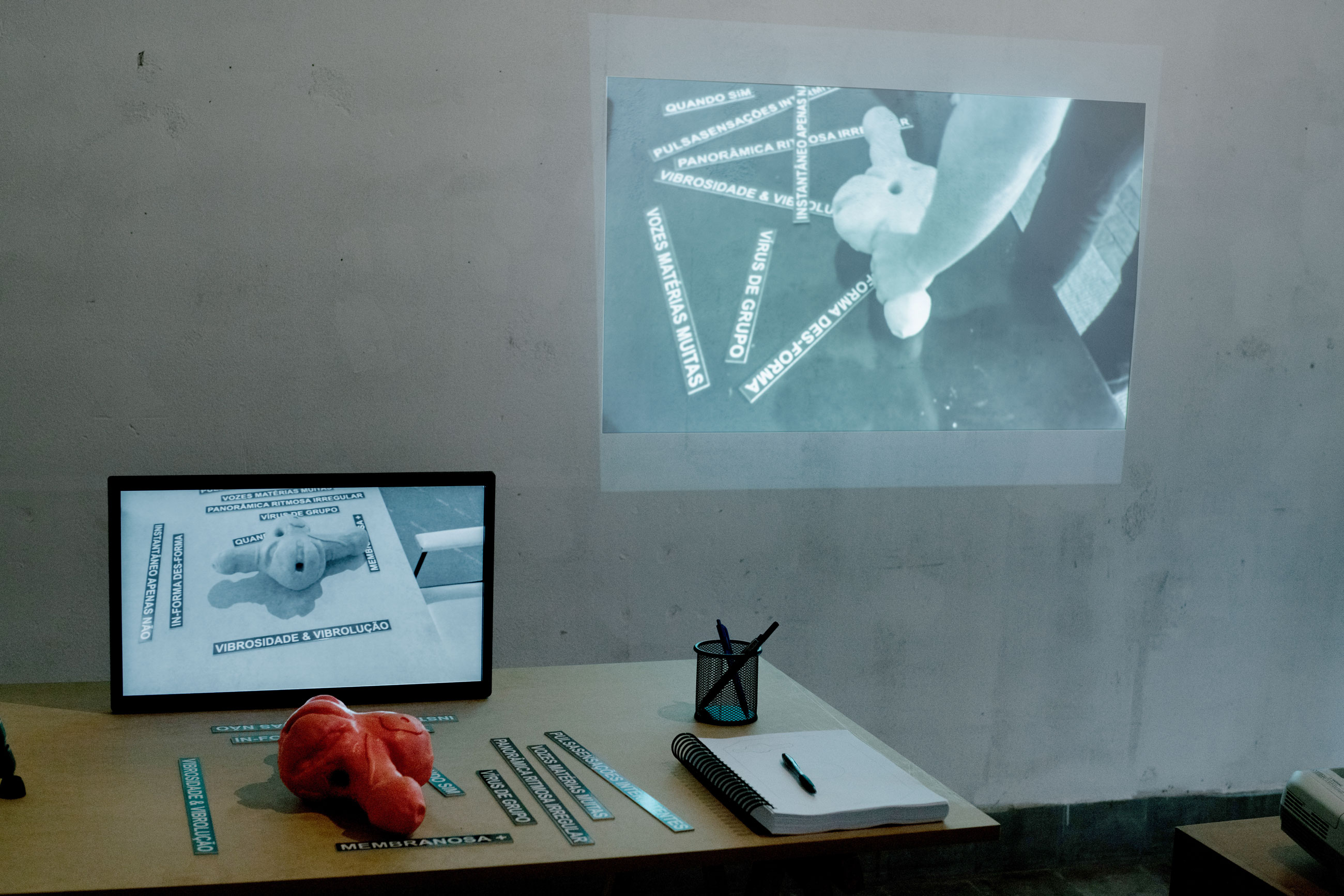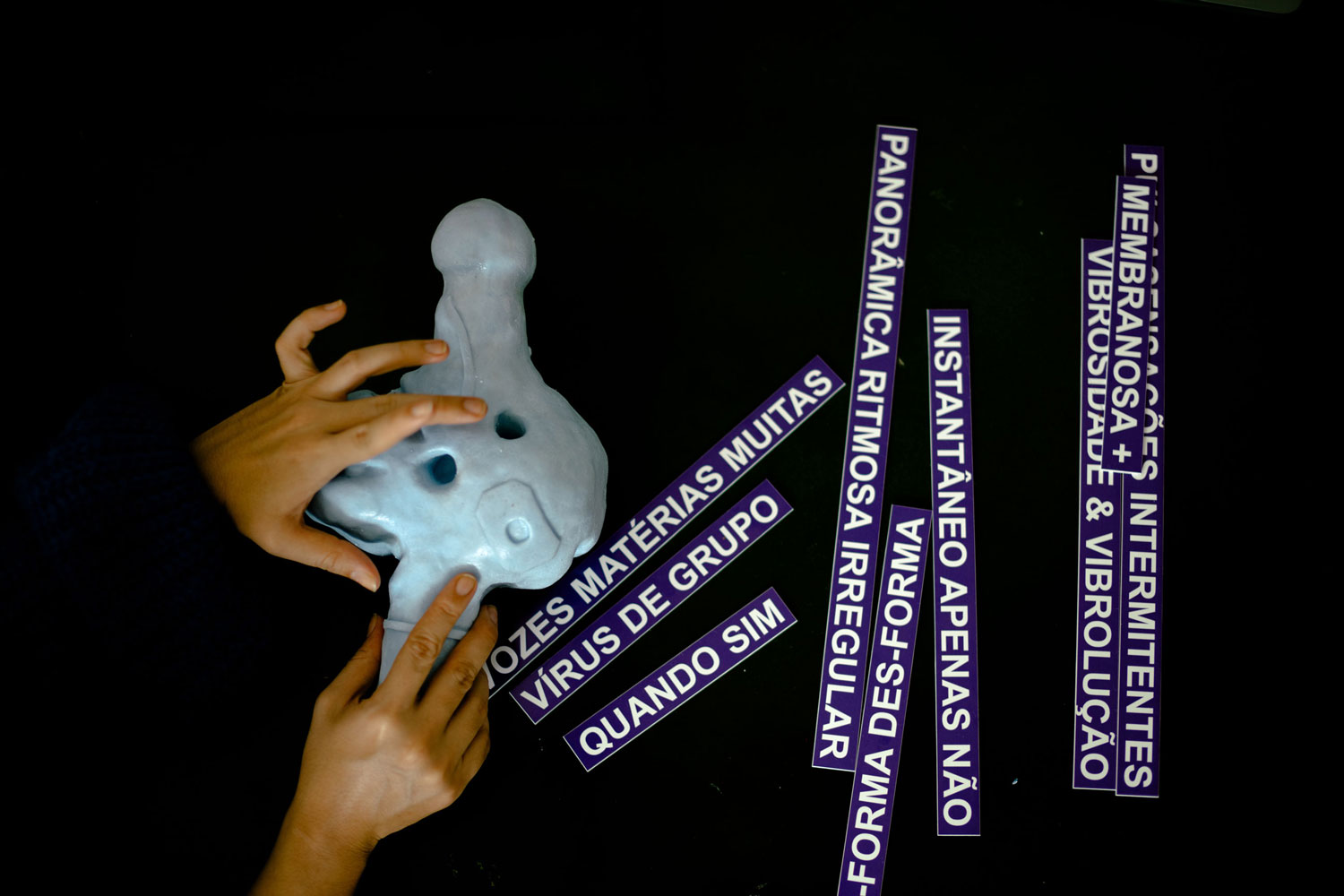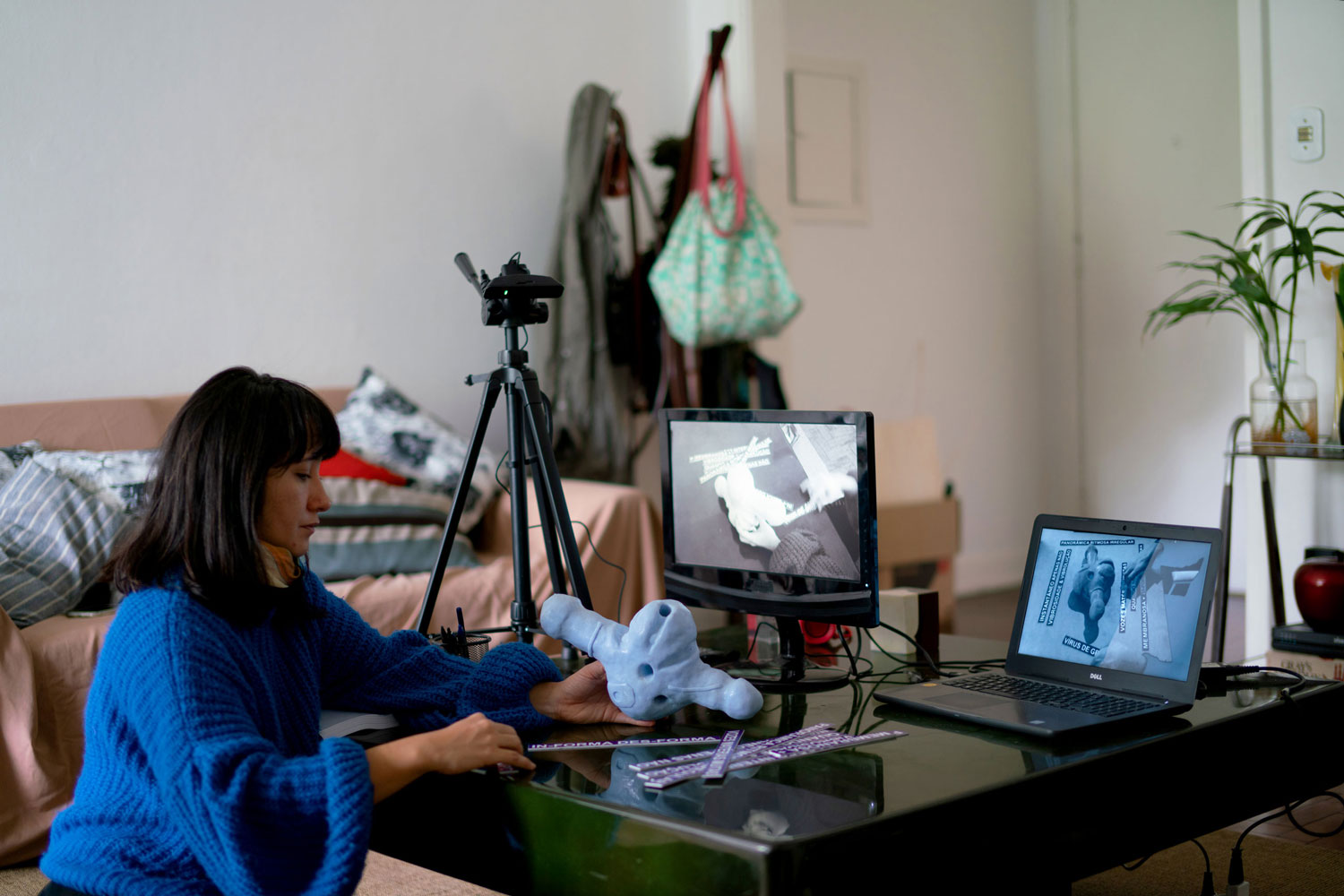System-Cinema: Ecstasy & Exercise
closeA closed-circuit video camera system captures images from the exhibition space at the gallery Jaqueline Martins and from a private dwelling in its surroundings, transmitting the footage in real time from one place to another. The cameras’ framing does not show the totality of these places, instead they close-up on two set of objects, one in each space. Each of the sets includes a silicone item, printed sentences and a notebook where new writings can be transcribed. Both the users of the domestic and the gallery space are invited to handle these objects, an action that is filmed and transmitted between spaces. The video images are periodically recorded and archived for later use in other videographic forms. After residing for a period of time in one domestic space, the set of objects outside of the gallery is taken to another dwelling, sequentially connecting the exhibition space to a series of houses in the neighborhood.1
Ricardo Basbaum, system-cinema: ecstasy & exercise, 2018, Jaqueline Martins Gallery & three domestic spaces. Photos by Haroldo Saboia.

The system-nomad enters the various domestic rites and rhythms. Its arrival is negotiated, anticipated and authorized by its hosts, under the condition of a temporary stay. The system-guest is accompanied by the live images of its "double," located in the gallery, and transmits a fragment of the domestic space-time to the exhibition space. The presence of this system-double is both corporeal and chimeric, underlining the interchangeability between inside and outside, between transient and fixed, and between belonging and remoteness. Such dualities, inherent to the very condition of the guest, contaminate the intimacy and interiority of the private sphere, creating a breach in the membrane that separates it from the outside. Even at the mercy of its host's rules, the guest’s presence automatically institutes another temporary system within the pre-defined mechanisms, triggering a reaction-reorganization of the frame that hosts it. The system-guest, established between the gallery and the residence, encourages and welcomes the participation of the users in its workings, becoming the host of an interaction between its objects and the different subjects that manipulate them. The handling of the pieces, when filmed and transmitted between both places, becomes simultaneously a performative and a voyeuristic act. On the one hand, it is an action performed to a distant receiver/audience, on the other, it is the contemplation and testimony of the activity that is being executed at a distance.

The static video shots show the pressing, stroking and gripping of the hands over the protrusions and crevasses of the silicone piece. The object’s shapes do not refer straightforwardly to anything known but are strangely familiar and close to the body. Its design does not follow ergonomic rules which would aim to optimize its handling or enhance the efficiency of a certain task. Its materiality seeks to incite and establish a familiarity with touch, stimulating the manual interaction and the corporal apprehension of the object’s figures. In the videos, the rhythm, the strength and the expressiveness of the hands, while handling this "in-utensil,"2 produce a narrative that is thickened by the written fragments which gravitate around the object. The printed words and expressions are continuously reorganized and recombined by the users of this system, and generate, at each new configuration, different messages and other syntaxes. The object and the words not only incite participatory circumstances but also the production of a thought about this process, which the "participator"3 can express through his own calligraphy on the notebook included in the set of objects. In the captured images, the relationship and negotiation between the protrusions and recesses of the silicon forms, of the handwriting, of the printed words and of the hands’ physiognomy, create a silent dialogue, a modality of interlocution where there is no predominance of a true single language and where any meaning is relative and provisional.4 In the absence of action, the video cameras witness the inert objects, still-lives that express the messages left by bygone gestural and bodily discourses.

The system is a generator and disseminator of processes of communicating otherwise. The invitation to manipulate the items and the words are also invitations for conversation, dialogue or soliloquy. The geometry of language structures the corporeal existence of the "self" and articulates its relation to the "other." Touch is one of the most effective forms of nonverbal communication in the transmission of a message, and is also one of the most effective ways to create a bond between individuals.5 Feeling the bodily topographies of the silicone piece brings the individual into his own body, while also connecting it indirectly to the body of the "other," which manipulates the replicated object at a distance. The piece is simultaneously a vehicle through which one has a concrete bodily experience and a virtual and symbolic extension of the subject towards the experience of the "other." System-prosthesis. Phantom limb. The shapes of the silicone object attribute a specific quality to the nature of its manipulation, which refer to the different modalities of intimate touch. This type of physical contact, considered private and personal, circumvents the logical and educable part of the mind and enters the primitive brain, the place of instinct, memory and desire. The intimate touch is the pinnacle of individuality and subjectivity, represents the closeness to oneself, self-discovery, the self that opens outwards, the understanding of the other and of otherness. But at the height of its non-transferability, intimate touch is also something profoundly collective, transversal to all, as a fleshly common-denominator. Universal language. Ecstasy.

The domestic space is the place that generates and preserves intimacy, allowing the maximum expression of individuality and subjectivity.6 It is also a device through which collective values and behaviors, which are above individuals, are implemented, unifying and leveling them. Habits and hierarchies produced in the micro-scale of domestic everyday life7 reverberate in the macro-scale of the socio-spatial dynamics. Conversely, "official" discourses convey the notions of "domestic" and "home" to political, economic, and ideological purposes.8 Today, the "home" is increasingly a permeable structure, which receives and transmits images, sounds and data, within a virtual relational network where the boundaries between the domestic and the public, and between individual and collective, distend and dissolve. The "intimate sphere" becomes a spectacle, a currency for exchange and an object of political management, carried out through techno-capitalism, biotechnologies, global media, social networks, and the citizens themselves. The res publica dodges away from the public and enters the intimate-domestic. It becomes omnipresent and dissipates. The exponential expectation of intersubjectivity and interactivity creates colliding nexuses between participation and voyeurism, between attachment and disconnection, between individuality and impersonality, and between the "self" and the "other." For the ocularcentric and vigilant society, the camera is the prosthesis of the eye. In an amnesic society, the recording is the prosthesis of memory. Fast-Forward. Friction-Fiction. Introjection-Projection. Replay. The History in a loop.
Ricardo Basbaum, system-cinema: ecstasy & exercise, 2018, Jaqueline Martins Gallery & three domestic spaces. Photos by Haroldo Saboia.

Action!
Curatorial text for system-cinema: ecstasy & exercise by Ricardo Basbaum, part of the project 1:1, Galeria Jaqueline Martins, São Paulo.
-
The work presented in the 3rd edition of the project 1:1 is part of the "System-Cinema" series that artist Ricardo Basbaum has been developing since 2001. This series consists of establishing a procedure for capturing, transmitting and recording images in real time, in conjunction with the construction of installations, interventions and objects that respond to the specificities of a given context.
-
Paulo Leminski, “A Arte e Outros Inutensílios” ("Art and Other In-utensiles”) in Folha de S. Paulo, caderno Ilustrada, p. 92, 18/10/1986.
-
Term-concept created by Hélio Oiticica to refer to the viewer as part of the artwork.
-
Ricardo Basbaum, “Conversations” (co-authored with Bojana Piškur) in Manual do Artista-etc, Azougue Editorial, Rio de Janeiro, 2013, p.203.
-
Although touch, as a physical act, is not an emotional event, the sensory stimuli carried from the skin to the brain provoke neural, glandular, muscular, and mental changes, which we call emotions. The amount of touching between individuals increases as a relationship becomes more personal.
-
The house, the basic cell of the organization of human space, is a space that goes beyond the basic needs of man, being understood by several authors as a reflection of memories, conflicts, desires and existential achievements. See, for example: "Building, Dwelling, Thinking" (1951) by Martin Heidegger or "The Poetics of Space" (1957) by Gaston Bachelard.
-
Such as the organization of work, the naturalization of repetition and routine, the binary and hierarchical construction of genres, the instrumentalization of sexuality, among others.
-
The relation between the "house" and the socio-political structure finds a specificity within the Brazilian context where there is historically a constant blurring between the public and private spheres. From early on, the house occupied a central place in the socio-spatial dynamics of the newly founded "nation," as Frei Vicente do Salvador in 1627 describes: "(...) things are shifted on this land, because all of it is not a republic, while each house being one." Gilberto Freyre, in 1933, emphasized the importance of the house in the Brazilian socio-cultural formation, arguing that the architecture of the colonial "big house" expresses Brazil's patriarchal mode of social and political organization. Roberto DaMatta, in 1977, explained Brazilian society through the reciprocity between the "street" and the "house". Sometimes the "house", the place of maximum intimacy, encompasses and totalizes society, sometimes the "street", the place of impersonality, encompasses the private life. These factors are the cause and effect of a patrimonial society.